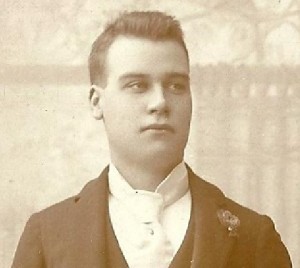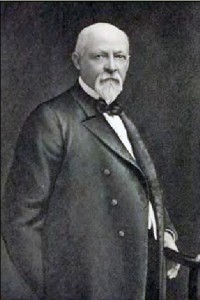
Burley Pixley
Sometimes family legends become embellished in the telling and other times the real story is much more dramatic than anyone knew. Such is the case with the Tale of Burley Pixley’s Death.
Several years ago my mother and I went to the Old Tacoma Cemetery. We were there to visit the Pixley family plot and noticed the largest of the family headstones was Burley Pixley’s. Burley was my great grandmother’s brother, making him my two times great uncle. My 90 year old mother remembered some of the story she had been told about Burley’s death. She knew Burley was a fireman for the Northern Pacific Railroad and the family story goes; one night a fellow fireman asked Burley to take his shift because that fellow’s wife was in labor with their first child. Burley agreed to work the shift but there was some kind of accident and he was killed. Mom was born 25 years after Burley died, so her story lacked firsthand knowledge. She had been told the story by her mother, who had been told by her mother – and anytime a story passes through multiple generations the details become fuzzy or lost. Burley’s story interested me and I wanted to know what really happened.
The Pixley family bible informed me that Burley married a girl named Leurie Jackson in 1895 and also recorded his death on November 29, 1897. Hoping for more details, I went online to the Washington State Digital Archives and found Burley’s Certificate of Death. There it was reported he died in a Tacoma hospital from “Scalds”.
Since he died in Tacoma I contacted the Tacoma Historical Society and they located a newspaper story published in the Tacoma Daily Ledger on November 25, 1897. The article described how, on November 23 in a mountain pass east of Tacoma, a tree fell across the railroad tracks and damaged the rails. That tree then slid on down the mountainside and falling snow hid any damage from the engineer of Burley’s approaching eastbound train. When it hit the damaged section of track the locomotive derailed and detached from the rest of the cars. With Burley still in the cab, the engine rolled down the mountainside and came to rest in a dry riverbed. Burley was trapped in the wreckage and scalded by escaping steam from the broken boiler. Passengers and crew from the cars above rushed down the hill to remove him from the wreckage. He was transported on a rescue train back to Tacoma and then to the Fannie Paddock Hospital.
Hoping to find more information, I went online to Genealogybank.com – which is a digital collection of old newspapers – and I found a number of articles about the tragedy.
The Tacoma Daily News reported that Burley was in the hospital and not expected to live. Then a few days later it was reported that Burley had died. The reporter wrote “He was conscious until a few hours prior to his death, and although he spoke but little he was rational. The physicians say he suffered no great pain shortly before the end.” A day later it was reported that Burley was buried and a “beautiful floral piece, representing a broken wheel, was laid by relatives on the casket”. That could have been the end of the story … but it wasn’t.
While searching Genealogybank.com, I found an article written eleven months after Burley died, reporting that Burley’s widow was suing the Northern Pacific Railroad for $30,000 in damages (that is over 850,000 in today’s dollars). She claimed negligence by the railroad had caused her husband’s death and her lawyers contended that the tree in question was well known by the railroad to be in poor condition and located too close to the rails. They also claimed the railroad should have employed a track walker ahead of the train in such bad weather, apparently a common practice for the day. The US District Judge in the case, Cornelius Holgate Hanford, disagreed with Leurie’s argument and dismissed her case in February 1899.

Judge Cornelius Hanford
I was not quite satisfied with the way this story seemed to end, so I continued searching and discovered information at historylink.org which indicated Judge Hanford’s decision may have been compromised by the railroad, who bought his rulings. According to historylink.org, in 1912 (thirteen years after his ruling in the Pixley case), Judge Hanford came under investigation by the US House of Representatives. They accused the judge of being intoxicated while on the bench and making corrupt ruling in favor of large corporations. Evidence was produced showing the Northern Pacific Railroad had sold Judge Hanford land under very favorable terms – this shortly after Hanford rendered a decision that saved the railroad more than $60,000. The Judge resigned just prior to further testimony that would have implicated other powerful interests in the Pacific Northwest, and the House dropped its investigation.
Leurie Pixley may have felt vindicated upon hearing the judge had been so disgraced, but it did nothing for her financial condition. After her case was dismissed she moved to Los Angeles where, according to the 1900 census, she became a stenographer. Leurie later married a man named George Mead who, like Burley, worked for the railroad. They had no children and divorced a few years later. Leurie Pixley Mead died in Los Angeles in 1925, at the age of 51.

 I don’t want to just find my ancestors; I want to discover their life stories and maybe unwind a few family mysteries along the way. Ancestry.com is great for identifying those long dead relatives, but sometimes the best information is not on line at all, sometimes you have to go looking for an original document in a courthouse or church. I love that kind of search, where my reward is finding a document that has been untouched for over a hundred years.
I don’t want to just find my ancestors; I want to discover their life stories and maybe unwind a few family mysteries along the way. Ancestry.com is great for identifying those long dead relatives, but sometimes the best information is not on line at all, sometimes you have to go looking for an original document in a courthouse or church. I love that kind of search, where my reward is finding a document that has been untouched for over a hundred years.
Recent Comments